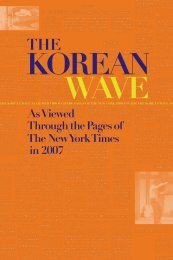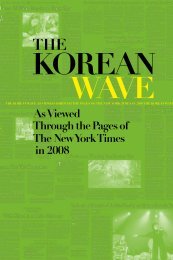The Korean Wave 2006 - Korean Cultural Service
The Korean Wave 2006 - Korean Cultural Service
The Korean Wave 2006 - Korean Cultural Service
You also want an ePaper? Increase the reach of your titles
YUMPU automatically turns print PDFs into web optimized ePapers that Google loves.
<strong>The</strong> New York Times, wednesday, July 12, <strong>2006</strong><br />
e1&5<br />
when real time<br />
turns out to be<br />
the most surreal<br />
of all<br />
By holland cotter<br />
Every day, hundreds of tourists snap photographs of<br />
a crowd-and car-jammed Times Square. <strong>The</strong> average<br />
picture takes – what? – 15 seconds to shoot?<br />
<strong>The</strong> same picture of the same place takes the <strong>Korean</strong> photographer<br />
Atta Kim eight hours. And his Times Square<br />
ends up with only an eerie trace of a human presence,<br />
like a deserted movie set.<br />
Other pictures by Mr. Kim, who is making an outstanding<br />
New York solo debut in a show titled “Atta Kim: On-Air”<br />
at the International Center of Photography, have required<br />
less time. A photograph of a soccer game: two hours. Of<br />
a couple having sex: one hour. Still others go way beyond<br />
the eight-hour mark. “Monologue of Ice,” with its mysterious<br />
lozenge of pollen-yellow light hovering in the dark,<br />
is the product of a marathon 25-hour shoot.<br />
And what is that picture of? A block of ice melting. Mr.<br />
Kim put the ice in a room and left the lens of his camera<br />
open to record the process of physical change as a solid<br />
form returned to fluid. Naturally, the transformation was<br />
slow. But who would have guessed that it would be so<br />
spectacularly photogenic – molten-looking and radiant?<br />
Many of the large-format photographs in Mr. Kim’s show<br />
were made over time. His is an art of duration and of simultaneity.<br />
When he leaves his lens open for an hour on<br />
a couple making love, every movement made in that hour<br />
is in the picture, though condensed into an explosive<br />
blur. His view of Times Square leaves all the stationary elements<br />
– buildings and such – in crisp focus, but reduces<br />
traffic to a shimmering haze, a ghost of motion. Other<br />
famous New York intersections get the same treatment.<br />
79





